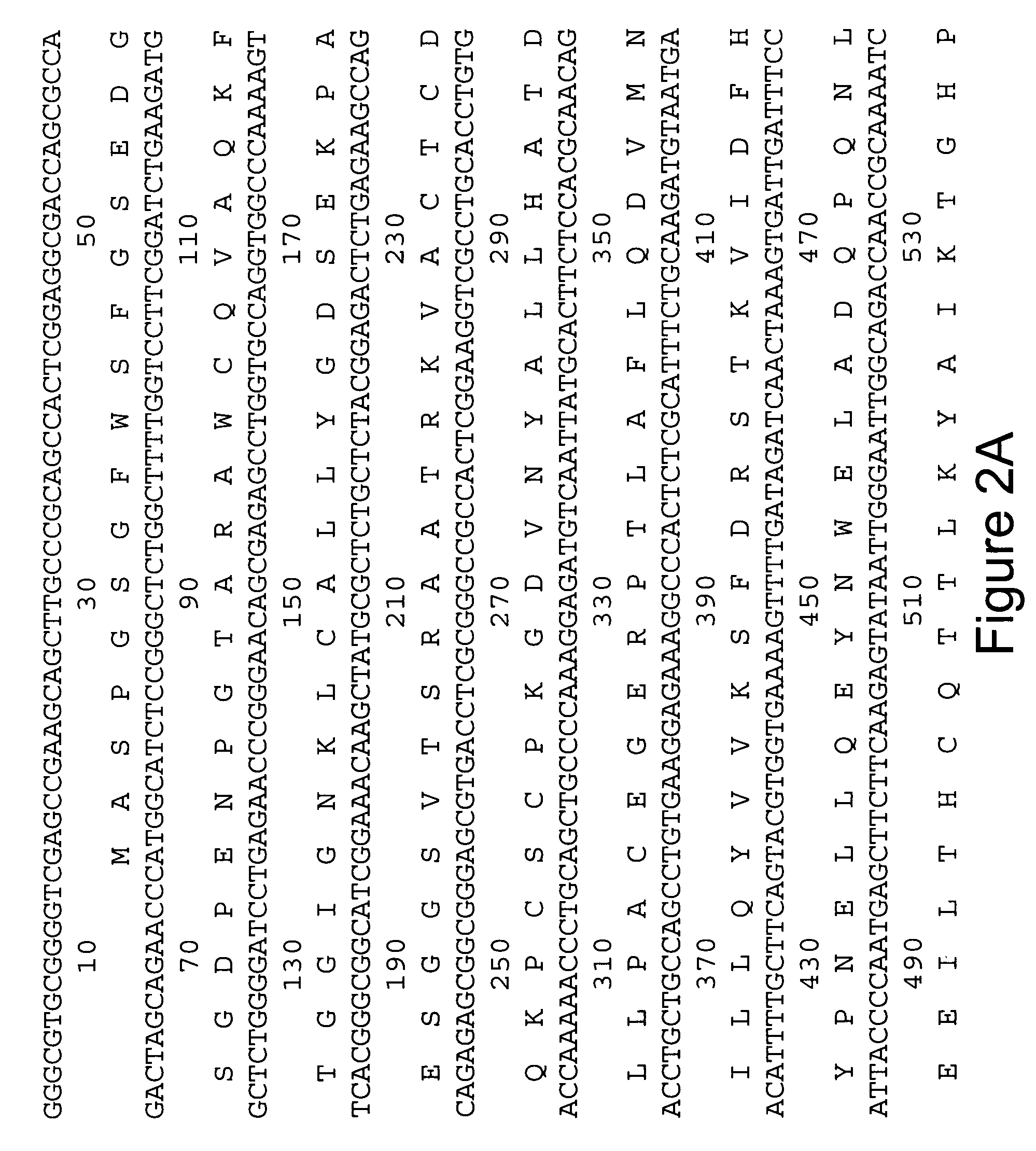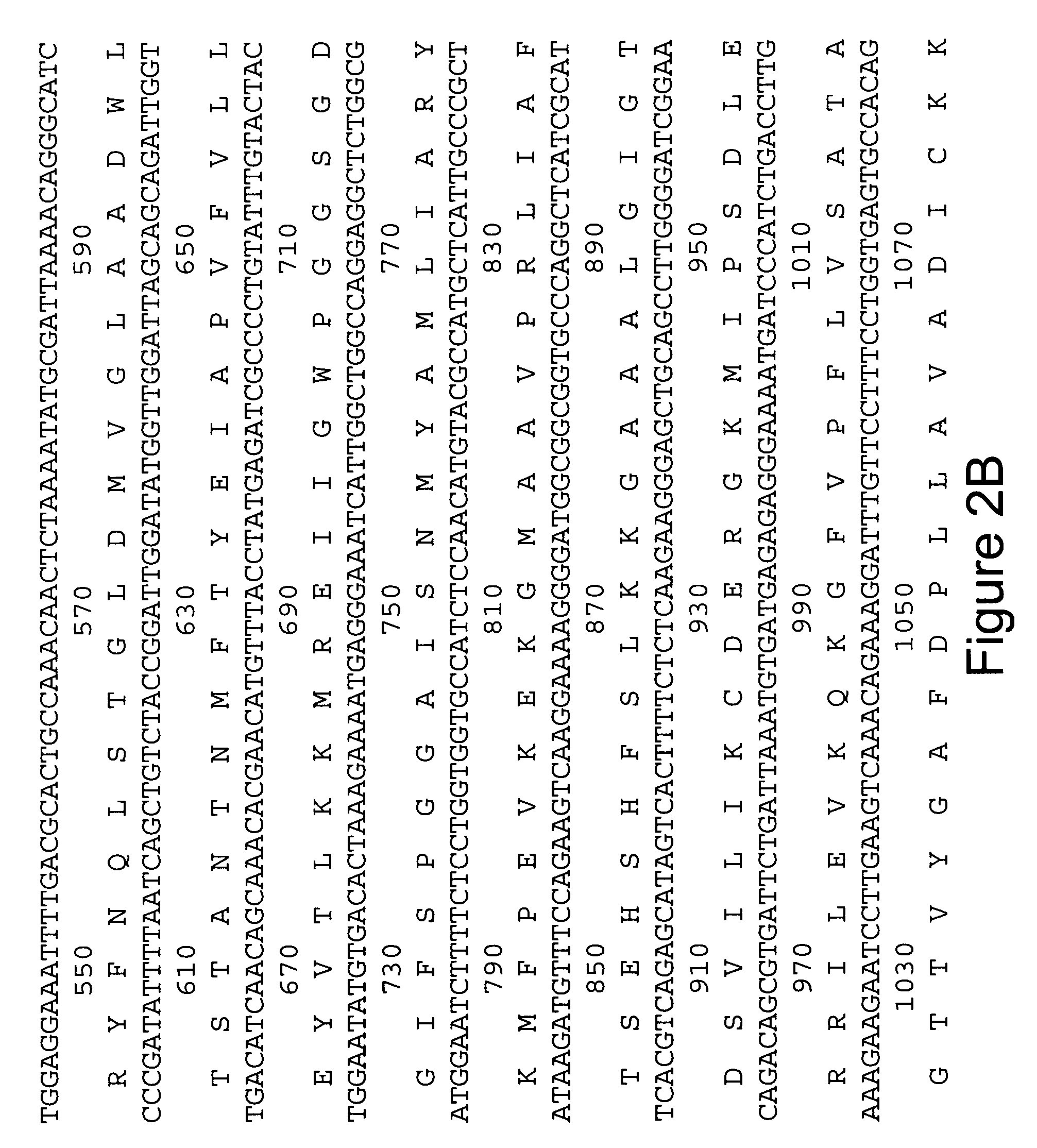Cloned glutamic acid decarboxylase
a glutamic acid and decarboxylase technology, applied in the field of recombinant dna technology, can solve the problems of cumbersome use of information as a diagnostic tool for predicting iddm, inability to completely restore metabolic homeostasis, and imperfect replacement, and achieve the effect of accurately classifying patients and increasing the quantity
- Summary
- Abstract
- Description
- Claims
- Application Information
AI Technical Summary
Benefits of technology
Problems solved by technology
Method used
Image
Examples
example 1
Cloning and Expression of GAD65
A. Recombinant DNA Procedures
[0060] In order to obtain cDNA probes specific for GAD65 and GAD67, total RNA was extracted from adult rat brain by guanidine isothiocyanate-cesium gradient using the method of Chirgwin, et al. (Biochemistry, 18: 5294, 1979). Poly (A) RNA was purified on oligo dT cellulose, using the protocol by Bethesda Research Laboratories (BRL). First strand synthesis was performed by using MMLV-reverse transcriptase (BRL), with conditions suggested, except that poly d(N6-mers (Pharmacia) were used as primers. This cDNA-RNA mixture was heat inactivated at 65° C. for 15 min and stored at −20° C. For PCR, 1 / 50 of the sample was added to the 1 00 μ1 reaction. Degenerate oligonucleotides were synthesized (Applied Biosystems) to encode the underlined common amino acid sequences of feline (from cDNA) (Kobayashi, et al., J. Neurosci., 7: 2768, 1987) and rat (from peptides) (Chang and Gottlieb, J. Neurosci., 8: 2123, 1988) GAD (FIG. 1). The ...
example 2
Characterization of Cloned GAD65
A. Northern Blot Hybridization
[0063] Two PCR-derived cDNA probes were hybridized to Northern blots containing rat brain RNA in order to determine whether the GAD67 and GAD65 cDNAs were derived from two different mRNAs. RNA was extracted as described in Example 1. Poly (A) RNA was separated by electrophoresis in formaldehyde and transferred onto Biotrans (ICN) membranes, and hybridization was performed as described by Well, et al. (J. Neurosci., 16: 311, 1986), except that 100 μl / ml of poly (A) was added. Probes were labeled to approximately 109 dpm / μg by the oligolabeling procedure of Feinberg and Vogelstein (Anal. Biochem., 132: 6, 1983). Identical results were subsequently obtained with full-length clones of GAD65 and GAD67 cDNAs.
[0064] As shown in FIG. 5, lanes 1 and 2 contain 1 μg of poly (A) selected RNA extracted from rat cerebellum. Lane 1 was hybridized to a cDNA probe for the rat cognate of feline GAD57 (Kobayashi, et al., J. Neurosci., 7...
example 3
Detection of Gad Autoantibodies in Clinical Specimens
A. Materials and Methods
[0092] 1. Patient Specimens. Sera from four groups of individuals were selected from a previous study by Atkinson and co-workers (Atkinson, et al., Lancet, 335: 1357-1360, 1990). These groups consisted of: Group (1), 1 new onset IDD patients diagnosed according to the established National Diabetes Data Group (NDDG) criteria (Gleichman, et al., Diabetes, 36: 578-584, 1987) that had been referred to the University of Florida, Diabetes Clinics; Group (2), 5 randomly selected islet cell cytoplasmic antibody (ICA) negative non-diabetic controls without any known family history of autoimmune disease; Group (3), 13 individuals whose sera had been collected 3 to 66 months prior to their documented clinical onsets of IDD; Group (4), non-diabetic controls and relatives, and those who were studied prior to their onsets of IDD; and Group (5), 3 patients at risk for IDDM, but where onset has not yet occurred. This la...
PUM
| Property | Measurement | Unit |
|---|---|---|
| pH | aaaaa | aaaaa |
| nucleic acid sequence | aaaaa | aaaaa |
| size | aaaaa | aaaaa |
Abstract
Description
Claims
Application Information
 Login to View More
Login to View More - R&D
- Intellectual Property
- Life Sciences
- Materials
- Tech Scout
- Unparalleled Data Quality
- Higher Quality Content
- 60% Fewer Hallucinations
Browse by: Latest US Patents, China's latest patents, Technical Efficacy Thesaurus, Application Domain, Technology Topic, Popular Technical Reports.
© 2025 PatSnap. All rights reserved.Legal|Privacy policy|Modern Slavery Act Transparency Statement|Sitemap|About US| Contact US: help@patsnap.com



